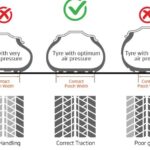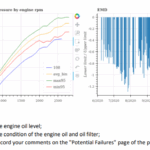Slide 1. Introduction.
The class develops what a tachograph is, how it works, what it is used for, and its implications for fleet management.
Slide 2. What is a tachograph?.
- Main functions of the tachograph.
A tachograph is a device installed in commercial vehicles, especially trucks and buses, that automatically records essential data while driving. It can be analog or digital, although digital models are more common today due to their ability to store more information accurately and securely.
This device is essential for complying with traffic and safety regulations and for preventing accidents.
The main functions of the tachograph are:
- Monitoring driving and rest times.
One of the most important functions of the tachograph is to monitor driving and rest times. Legislation establishes a maximum number of driving hours and a minimum rest period to prevent driver fatigue. The tachograph helps to comply with these regulations, as it records in detail each period of activity and inactivity of the vehicle.
- Speed recording.
It constantly records the speed of the vehicle to ensure that speed limits are respected. This function is essential for verifying compliance with traffic regulations and for investigating accidents.
- Distance traveled recording.
It measures and stores the total distance traveled by the vehicle, providing important data for logistics planning and vehicle maintenance. This information is essential for monitoring routes and optimizing delivery itineraries.
- Printing records.
Digital tachographs usually include a printer that allows vehicle activity records to be printed directly from the device, facilitating inspections and monitoring by authorities and transport companies.
- How does a tachograph work?.
In digital tachographs, each driver has an identification card that they must insert into the device at the start of their working day. This card records who is driving, allowing driving data to be associated with the corresponding driver.
Once activated, the tachograph automatically records all vehicle activity, including speed, distance traveled, and driving and rest times. Any changes in activity, such as rest stops or changes in tasks, must be entered manually.
At the end of the day, the driver must indicate on the tachograph where their day ends and remove their card to ensure that all the information for the day is correctly stored and closed.
Each country has its own legislation, but they all have the same objective: to monitor drivers' driving and rest times. The case of Spain is developed below.
- Tachograph requirement.
All vehicles registered in European Union member states that are used for the transport of passengers or goods by road and whose drivers are covered by Regulation (EC) No. 561/2006.
- Vehicles used for the transport of goods.
When the maximum authorized mass of the vehicles, including trailers or semi-trailers, exceeds 3.5 tons.
From July 1, 2026, in international or cabotage transport operations, this measure will apply to vehicles with a maximum authorized mass exceeding 2.5 tons.
- Vehicles used for passenger transport.
Vehicles manufactured or permanently adapted to carry more than nine people, including the driver, and intended for that purpose.
- Tachograph exceptions.
There are many exceptions to the use of tachographs. It is recommended that you check whether your type of service or vehicle is exempt from using a tachograph.
Some of the exceptions are outlined below.
- Transport of goods by vehicles powered by electricity or natural or liquefied gas, whose maximum authorized mass, including that of trailers or semi-trailers, does not exceed 7.5 tons, provided that they are carried out entirely within a radius of 50 kilometers around the center of operation of the company that owns or leases the vehicle.
- Vehicles used for the transport of passengers on regular services where the route of the service in question does not exceed 50 kilometers.
- Vehicles with a maximum authorized speed not exceeding 40 kilometers per hour.
- Vehicles purchased or rented without a driver by the armed forces, civil defense, fire departments, and forces responsible for maintaining public order, when the transport is carried out as a result of the function entrusted to these bodies and under their responsibility.
- Vehicles, including vehicles used for the non-commercial transport of humanitarian aid, used in emergencies or for rescue operations.
- Special vehicles used for medical purposes.
- Vehicles specialized in repairing breakdowns with a range of 100 kilometers around their operating center.
- Vehicles or combinations of vehicles with a maximum authorized mass not exceeding 7.5 tons used for non-commercial transport of goods.
- Transport carried out for the disposal of waste within a radius of 50 kilometers around the operating center of the company that owns or leases the vehicle.
Slide 3. Fines imposed by the General Directorate of Traffic for driving without a tachograph card.
- When is it permitted to drive without a tachograph card?.
There are exceptional situations in which it is possible to drive without one, but always under certain conditions. However, if the offense is not justified, the penalties can be severe, both for the driver and for the transport company.
- Loss, theft, or damage to the card.
If the card has been lost, stolen, or damaged, you can continue driving for a maximum of 15 days while you arrange for a duplicate. However, you must manually record your driving times and print out the tachograph activity.
- Delay in renewal.
If the card has expired but you requested renewal at least 15 working days before the expiry date, you can continue driving until you receive the new card. However, this margin is only valid if the delay in delivery is not attributable to the driver.
- Travel within the company.
The use of the card is not mandatory for travel within the company's premises outside working hours. However, it is recommended that an internal record of these movements be kept.
- How to manually record activities.
If you are forced to drive without a tachograph card in one of the permitted cases, you must keep a manual record of the vehicle's activity to avoid penalties.
- Before starting the day.
Note the starting point and print a tachograph report with the activity history for the last 24 hours. Then write your name, card number, and signature on the back of the document.
- While driving.
Record driving times, breaks, and rest periods in accordance with legal requirements.
- At the end of the day.
Indicate the arrival location, print a new report with the summary of the day, and check that all the information is correct.
These reports must be kept in good condition, as the authorities may request them in the event of an inspection.
- Situations in which driving without a card is not permitted.
Although there are exceptions for driving without a tachograph card, there are circumstances in which driving without one is completely prohibited and can result in severe penalties.
- Regular use without a card.
If a driver drives without a card, unless it is one of the justified cases, it is considered a serious offense.
- Interruption of rest.
Previously, it was permitted to move the truck without a card for less than 15 minutes without affecting the rest record. Currently, this practice is no longer permitted.
- Tampering with the tachograph.
Attempting to take advantage of the “one-minute rule” to avoid recording driving times can be detected by the authorities and penalized.
The one-minute rule of the digital tachograph states that it will record the activity, driving or rest period that lasted the longest within a full minute. For example, if you drove for 29 seconds and rested for 31 seconds during a minute, the tachograph will count that full minute as “rest.” This rule allows drivers to count less driving time in certain circumstances, such as traffic jams, but its use is illegal if it is used to interrupt regulatory breaks or rest periods.
- Fines for driving without a tachograph card.
Fines for non-compliance with tachograph regulations can be very high, especially if there is evidence of an attempt to conceal data or alter records.
- Fines for drivers.
€2,001 if you drive without a card in a case where it is not permitted or use another driver's card.
€4,001 if you tamper with the tachograph or falsify data.
- Fines for companies.
From €4,001 to €6,000 if the company allows its drivers to drive without a card or manipulates the records.
- Main tachograph fines.
The main fines are for:
- Misuse of the tachograph.
- Excessive hours worked.
- Insufficient rest.
These can in turn be divided into very serious offenses, €2,001 to €6,000, serious offenses €401 to €2,000, and minor offenses €200 to €400.
- How to avoid penalties and legal problems.
To avoid penalties related to the tachograph, we recommend following these tips:
- Apply for renewal in advance to avoid unforeseen circumstances.
- Always carry your tachograph card with you and check that it is valid.
- If you lose it, report it immediately to the authorities and keep a manual record of your activity.
- Comply with driving and rest times to avoid negative inspections.
- Consult experts in transport regulations to keep up to date with legal changes.
The penalty for driving without a tachograph card can be very high, reaching up to €4,001 in cases of data manipulation. However, there are exceptional circumstances in which driving without one is permitted, provided that accurate manual records are kept.
Slide 4. Implications for fleet management.
- The main consequences are fines, penalties imposed by the authorities, and the possible immobilization of the vehicle, meaning it cannot be used to provide the service.
- There are many exceptions to the tachograph requirement, so it is important to know whether our activity or vehicles do not require the use of a tachograph.
- Regulations must be complied with, cards must be renewed in advance, and activity must be recorded correctly to avoid fines and legal problems.
- It is recommended that the traffic manager or another employee related to the fleet manage the tachograph.
- It is advisable that the fleet manager does not perform this task due to the time it takes, and instead focuses on the most important activities of fleet management.
- The tachograph must be maintained so that it works properly.
- Drivers must be trained on how to use the tachograph, what is and is not permitted, driving and rest times, etc.
- Tachograph technology and regulations evolve over time, so it is important to stay abreast of new technology and regulations each year in order to implement them in vehicles.
For example, in 2023, it became mandatory to install the new second-generation tachograph in vehicles that meet a series of characteristics related to the type of load or route.
As of December 31, 2024, all vehicles already registered for international transport must have a second-generation tachograph.
In short, the tachograph is an indispensable tool for the transport industry, as it ensures safety and compliance with traffic regulations. Its use encourages more responsible driving, helps prevent accidents, and ensures compliance with driving and rest time regulations by drivers and companies. As technology advances, the use of tachographs has become more sophisticated and fundamental to daily road transport operations.
Slide 5. Thank you for your time.
The class has developed what a tachograph is, how it works, what it is used for, and its implications for fleet management, see you soon.
Download the audio




















